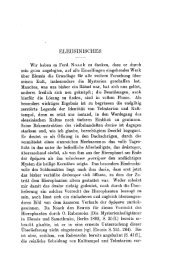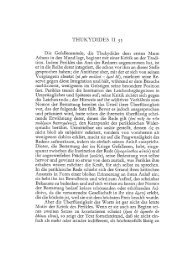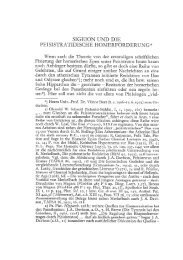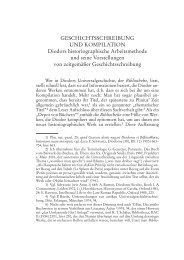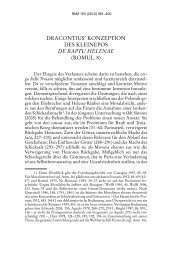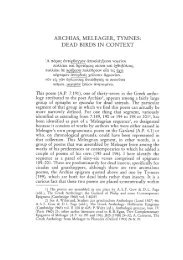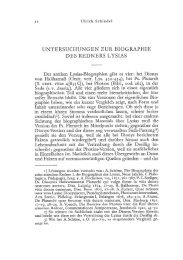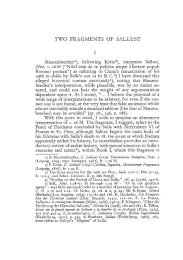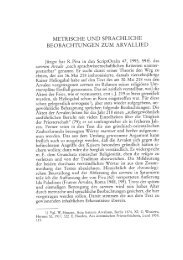PRECATIO TERRAE AND PRECATIO OMNIUM HERBARUM
PRECATIO TERRAE AND PRECATIO OMNIUM HERBARUM
PRECATIO TERRAE AND PRECATIO OMNIUM HERBARUM
Create successful ePaper yourself
Turn your PDF publications into a flip-book with our unique Google optimized e-Paper software.
5<br />
10<br />
<strong>PRECATIO</strong> <strong>TERRAE</strong><br />
<strong>AND</strong> <strong>PRECATIO</strong> <strong>OMNIUM</strong> <strong>HERBARUM</strong><br />
The text of these prayers is preserved in four manuscripts.<br />
Baehrens listed them as follows').<br />
A Codex Leidensis M.L.V.Q. 9 of the sixth century.<br />
B Codex Vratislaviensis 3 F. 19 of the eleventh century.<br />
C Codex Laurentianus 73.41 of the eleventh century.<br />
D Codex Laurentianus 73.16 of the thirteenth century.<br />
The condition of the text of the prayers in the codices is<br />
strange. Baehrens says') that they were copied in a continous form<br />
as if they were prose in A, B, and C. In D they were written as<br />
some type of verse. In A there were some slight signs of interpunctuation<br />
and in Band C here and there initial letters. Riese<br />
comments J ) that both involve the greatest difficulty in emendation<br />
because, before they were copied into our manuscripts, they had<br />
been distorted at times into a form like prose by persons destitute<br />
of a poetic sense. The efforts of these two scholars were directed<br />
towards recovering or reconstituting the texts as poems from the<br />
words which were preserved in the four codices. A new examination<br />
of the evidence, however, shows that this is excessive.<br />
In A the Precatio Terrae is called a carmen. The metrical<br />
pattern is iambic senarius. The first 24 lines are poetry, but the<br />
balance is prose. A text is here presented and comments follow.<br />
Dea sancta Tellus, rerum naturae parens,<br />
quae cuncta generas et regeneras sidera,<br />
quae sola praestas te tutelam gentibus,<br />
caeli ac maris diva arbitra rerumque omnium,<br />
per te quiescit natura et somnum capit,<br />
itemque lucem reparas et noctem fugas;<br />
tu Ditis umbras tegis et immensum chaos,<br />
tu ventos imbres tempestates contines<br />
et cum libet dimittis et misces freta<br />
fugasque soles et procellas concitas,<br />
itemque cum vis hilarem promittis diem.<br />
1) E. Baehrens, Miscellanea Critica (Groningen 1878) p. 107f.<br />
2) Ibid. p. 108.<br />
3) A. Riese, Anthologia Latina (Teubner, Leipzig 1894) p. xi f.
176 John I. Me Enerney<br />
Alimenta vitae tribuis perpetua fide<br />
et eum reeesserit anima in tete refugimus<br />
et quidquid tribuis in te euneta reeeidunt.<br />
15 Merito voearis magna tu mater deum<br />
pietate quia vieisti divum numina<br />
et illa vere es gentium et divum parens<br />
sine qua nee moritur quicquam nec nasci potest.<br />
Tu magna tuque divum regina es, deal<br />
20 Te, diva, adoro tuumque ego numen invoco<br />
facilisque praestes hoc mihi quod te rogo<br />
referamque, diva, gratias merita fide.<br />
Exaudi me, quaeso, et fave coeptis meis.<br />
Hoc quod peto a te, diva, mihi praesta volens.<br />
Herbas quascumque generat tua maiestas salutis causa tribuis<br />
cunetis gentibus. Hanc mihi permittas medicinam tuam. Veni ad<br />
me cum tuis virtutibus. Quidquid ex his fecero, habeat eventum<br />
bonumj cuique easdem dedero, quique easdem a me acceperint,<br />
sanos eosdem praestes. Nune, diva, postulo ut hoc mihi maiestas<br />
praestet quod te supplex rogo.<br />
The first line illustrates the meter perfectly. The text of line<br />
2, however, as transmitted in the manuscripts is imperfect. In A it<br />
reads que cuncta generans et generas sidus. In Band D it is que<br />
cuncta generas et regeneras sidus. Baehrens reports') that Schneider<br />
emended it to sidera and Buecheler to in dies. Schneider's eorrection<br />
is the best, is dosest to the manuseript reading and is suited to<br />
the meaning of lines 4, 6, and 10. ParalleIs to the thought are seen<br />
in Cicero, circuitus solis et lunae reliquorumque siderum S ), in<br />
Horace 6 ) who calls the moon siderum regina bicornis and in Quintilian'),<br />
solem lunamque praecipua siderum. The eoneept is of a<br />
geoeentric system with sun, moon and the other stars cirding the<br />
earth. Riese') aecepted Bueeheler's in dies, but Baehrens emended<br />
sidus to indidem, and in his Miscellanea Critica refers to Catullus<br />
61.207 f, sed indidem / semper ingenerari 9 ). He was attracted by<br />
the verb in Catullus as a parallel to generas et regeneras and<br />
4) E. Baehrens, Poetae Latini Minores (Teubner, Leipzig 1879-83) p. 138.<br />
5) De natura deorum 2.62.155.<br />
6) Carmen saeculare 35.<br />
7) Institutiones oratoriae 2.16.6.<br />
8) Op. eil. p. 26.<br />
9) R. A. B. Mynors, C. Valerii Catulli Carmina (Oxford at the Clarendon<br />
Press 1958) p. 49.
Preeatio Terrae and Preeatio Omnium Herbarum 177<br />
adopted indidem. In Catullus the word does not refer to the<br />
feminine side of marriage at all, but to the male. He was honoring<br />
the wedding of Manlius Torquatus and it was the distinguished<br />
name of that family that should be continued in his sons. This is<br />
an instance where Baehrens' scripsi "is usually ominous of alterations<br />
so arbitrary as to amount to a rewriting of the Latin."'O)<br />
Schneider's change to sidera is to be preferred. The thought of line<br />
2 with this reading is mirrored in Orphic Hymn 26, lines 8 and 9,<br />
where earth is hailed as the one "around whom the much wrought<br />
universe of stars / revolves."")<br />
In line 3 the reading of the codices, quod sola praestas gentibus<br />
tutela, fails metrically and if tutela is nominative praestas has<br />
no accusative object. Baehrens emended tutela to vitalia citing<br />
Livy 6.40.12 as source, but there the word is singular, vitale. He<br />
intended the plural to mean "the needs of life." But the lines are<br />
considered to be post-Augustan") and in Lucan 7.620 and 9.743<br />
vitalia means "vital organs." In Seneca Ep. 99.22 it means<br />
"graveclothes." It has the same meaning in Petronius 77.7, for<br />
Trimalchio is holding a rehearsal of his funeral. There is a pre<br />
Augustan use in Lucretius 2.575 vitalia rerum, but he is speaking<br />
of things dying and in the Precatio the opposite is the case. Duffs'<br />
translation of Baehrens' text is "because thou only dost supply<br />
each species with living force."") But gentibus does not mean<br />
"species." This is repeated for line 17, and then in 26 cunctis<br />
gentibus is rendered as "upon every race." The translators are not<br />
consistent. The conclusion is that Baehrens' choice of vitalia for<br />
tutela was unfortunate and complicated the meaning of the line.<br />
Riese changed tutela to the accusative case 13 ), transposed<br />
words inserting tuam, and offered quod sola praestas tuam tutelam<br />
gentibus. Placing gentibus in the final position is metrically an<br />
improvement. He took tutelam to mean "protection," but the use<br />
of praesto with an accusative following a reflexive is found in<br />
IX.<br />
10) J. W. and A. M. Duff, Minor Latin Poets (Loeb, Harvard Press 1935) p.<br />
11) G. Quandt, Orphei Hymni (Weidmann, Berlin 1955) p. 22. The Greek<br />
text is here translated. He set the date for the hymns in the time of the Roman<br />
empire (Prolegomena p. 44). Baehrens (Miscellanea Critica p. 109) attributed the<br />
anthem 10 earth 10 Antonius Musa, the physieian of Augustus, but later seholars<br />
disagree and Duffs' statement (op. eit. p. 340 f.) is now aeeepted, that it is also<br />
from the time of the empire.<br />
12) Op. eit. p. 343.<br />
13) Op. eit. p. 26.<br />
12 Rhein. Mus. f. Philol. 126/2
178 John I. Me Enerney<br />
Cicero, Fam. 1.6.2 praesta te eum qui, in Lucretius 3.219 f. se<br />
incolumem, in Ovid, Tr. 4.10.104 se invictam, and again in 4.5.23<br />
with an adverb. By metonymy tutela means "protectress." The<br />
reading should be tutelam with te preceding instead of tuam. By<br />
the simple error of haplography a scribe omitted it because of -tein<br />
the medial syllable of the next word.<br />
Schneider had suggested that the first word be changed from<br />
quod to quae. 14 ) This makes eminent sense for the pattern of poetic<br />
prayer in both Greek and Latin was to invoke a divinity and then<br />
begin a list of divine attributes or acts using a relative pronoun.<br />
This is first seen in Iliad 1.37-42 and 3.276-292 as weIl as elsewhere<br />
in Homer. In the Homeric Hymns this pattern is used in<br />
fifteen of the smaller poems"). Lucretius used it in the address to<br />
Venus at the beginning of his work, as did Horace in Car. 1.10,<br />
3.22 and in the Carmen saeculare, line 9. Accordingly, line 3 can<br />
be reconstituted as quae sola praestas te tutelam gentibus.<br />
The invocation continues on line 4. In A the reading is arbitratumque<br />
rerumque. In Band C it is arbitrarumque. The reading<br />
of D, arbitra rerumque, is accepted as proper in sense and meter.<br />
In A and C line 5 reads per quem silet natura et somnus capit.<br />
This was corrected in B to quem and to quam in D. B has somnos<br />
and D has somnum. Riese printed the line as per quam silet natura<br />
et somnos capit and accepted hiatus between natura and et.<br />
Baehrens chose elision and compensated for the lost syllable by<br />
changing capit to concipit. This is arbitrary since the verb is not<br />
used with somnum, while somnum capere is attested in Plautus,<br />
Mi!. 3.1.115 and Cicero, Tusc. 4.19.44. Hence capit is the proper<br />
idiom. The reading somnus in A is best changed to somnum of D,<br />
rather than somnos of B, which introduces a plurality, although<br />
this is defensible since nature is personified as asleep at night and<br />
can be conceived as doing this regularly. However, the metrical<br />
problem of the first part of the line remains. The style of the<br />
poetic part of the Precatio is rather simple. The lines are endstopped,<br />
there is no instance of enjambement, and there is no<br />
other use of techniques such as hiatus. If in some places the poem<br />
was changed into prose before the period of our manuscripts, silet<br />
may have replaced quiescit, a more poetic verb with the same<br />
meaning. lt has the required number of syllabIes to heal the metrical<br />
problem. Moreover, the use of per quam at the start of the line<br />
14) Reported by both Baehrens and Riese in app. crit.<br />
15) Hymns 6, 9, 11, 15, 18, 19,20,22,23,24,26,27,29,30 and 32.
Precatio Terrae and Precatio Omnium Herbarum 179<br />
is against the pattern of poetic prayer in which the second person<br />
pronoun is emphatic after the invocation of the divinity. Duffs'<br />
translation shows that they were aware of the problem, for they<br />
wrote "through thee is nature hushed and lays hold on sleep."16)<br />
Thus line 5 would read per te quiescit natura et somnum capit.<br />
This continues the invocational second person. The vocative Dea<br />
saneta Tellus begins the poem followed by two relative clauses in<br />
the second person. Line 4 continues the vocative, and if quam is<br />
used in line 5, there is a break in the thought, for the verbs are in<br />
the third person. Yet throughout the poem the second person is<br />
dominant. Instead of per quam, therefore, per te is more fitting.<br />
Lines 6 and 7 present no textual problems. Line 8, however,<br />
ventosque et imbres tempestatesque contines, as it is in the codices,<br />
has too many syllables. Riese changed tempestatesque to tempestive,<br />
altering the meaning. Baehrens changed contines to attines in<br />
an attempt to solve it by elision. This leaves an excessive number<br />
of conjunctions in lines 8, 9 and 10. If line 8 began with tu,<br />
following the pattern of poetic prayer, and if the conjunctions are<br />
omitted, contines can be preserved I7 ). This asyndeton is seen in<br />
Cicero de nato deorum 3.51 ergo imbres nimbi procellae turbines<br />
dei putandi.<br />
Line 9 contains no problems. For line 10 the codices have<br />
fugasque solem et procellas concitas. Riese kept this allowing hiatus<br />
again. Baehrens changed solem to soles which avoids hiatus and<br />
makes better sense. The plural of procellas supports it. One violent<br />
storm in a day is the way of nature. If the singular is kept as<br />
Riese chose, the reading should be procellam. Line 11 contains no<br />
problems and this ends the first part of the anthem in which the<br />
power of earth over nature is asserted.<br />
The manuscripts begin line 12 with et. Baehrens emended it<br />
to tu. Riese dropped et, and this seems to be correct, since a new<br />
thought in the verses is starting, the power of earth over mankind.<br />
In line 13 the manuscript reading et cum recesserit anima in te<br />
refugimus lacks a syllable to be metrical. Baehrens supplied one by<br />
tete. This is to be preferred to Riese's change of refugimus, a<br />
general present tense, to the future refugiemus, which ends the line<br />
with a spondee.<br />
16) Op. cit. p. 343.<br />
17) Cf. Paul de Winterfeld, Philologus 58, 1899, p. 288, where this reading<br />
was first suggested.
180 John I. Me Enerney<br />
In line 14 the transmitted text is ita quidquid tribuis in te<br />
cuncta recidunt. Both scholars accepted it. Yet the word ita is so<br />
totally prosaic that it should be emended to et. Punctuation was<br />
not used when the poem was composed. The use of ita makes the<br />
line be a conclusion of the two preceding. Without punctuation in<br />
prose we would expect itaque. In the simple style of this poem,<br />
however, et and the line which follows sum up in quidquid all that<br />
earth gives t.o mankind which is returned to her. As printed in<br />
their texts the last word in the line, recidunt, is not metrical because<br />
the first syllable is short. If the prefix is to have the impact of<br />
red-, orthography would require the spelling reccidunt, as in<br />
Propertius 4.8.44 and Juvenal 12.54.<br />
Line 15 contains no problems and in 16 the reading of the<br />
codices nomina was rightly emended by Riese to numina.<br />
In line 17 the text of A is tu illa vere es gentium et divum<br />
parens, while B, C, and D begin the line with tum. Within the line<br />
Band C have ver et and D has vero. Riese in an attempt to uphold<br />
A and to avoid elision between tu and illa offered tu es illa vere<br />
gentium et divum parens. This causes an awkward elision between<br />
tu and es, both monosyllabies. Baehrens changed in to tuque illa<br />
vera es. This also causes repeated elisions, the basic problem in A.<br />
It is much simpler if we emend tu to et.<br />
In the manuscripts line 18 reads sine qua nec maturatur quicquam<br />
nec nasci potest, which is too long by a foot. Both editors<br />
dropped quicquam and emended nec to nil, offering sine qua nil<br />
maturatur nec nasci potest. But this presents the odd hysteronproteron<br />
of maturity before birth. Schneider had recommended<br />
nec moritur quicquam. This holds to quicquam of the codices, is<br />
metrical, and the thought sequence is preserved. In lines 12 to 14<br />
the topic is earth's power over man and man's return to earth at<br />
death. Logically moritur in line 18 should precede nasci for this is<br />
the. way of earth, death and then birth; autumn, winter, and<br />
spnng.<br />
For line 19 the codices offer tu es magna tu es divum regina<br />
dea. This fails as verse even if we accept two instances of hiatus in<br />
a single line. Baehrens emended it to read tu es magna tuque<br />
divum regina es, dea. Riese changed it to tu es magna, tuque<br />
divum regina ac dea. In both, the line begins with the elision<br />
between tu and es which can be avoided by dropping the second<br />
word, es. The verb is used later in the line.<br />
Lines 20 and 21 contain no textual or metrical problems. In A<br />
and C the next passage reads: referamque gratias diva tibi merito
Precatio Terrae and Precatio Omnium Herbarum 181<br />
lide exaudi queso etlabe coeptis meis. Baehrens emended gratias to<br />
gratis and merito to merita, and ended line 22 after lide. Riese<br />
made gratias the third word in the line, treated merito as an adverb<br />
or ablative of cause of the noun meritum, and reversed the order of<br />
tibi merito. At this point he ended line 22. Both strove to rearrange<br />
prose into verse. The two versions are:<br />
Baehrens: releramque gratis, diva, tibi merita lide.<br />
Riese: releramque, diva, gratias merito tibi.<br />
They evidently felt that tibi was to be preserved, although the<br />
vocative diva made it obvious that thanks would be rendered to<br />
her. If tibi is omitted the line can easily be emended: releramque,<br />
diva, gratias merita lide.<br />
For line 23 Baehrens inserted me after exaudi for metrical<br />
reasons. This correction is much better than Riese's attempt. He<br />
dropped lide from the preceding line, changed it to rite, inserted it<br />
into line 23 and wrote me before it. Baehrens stayed closer to the<br />
manuscripts. The text of line 24 presents no problems.<br />
Both editors continued a reconstruction of the Latin words<br />
which follow into the same form of verse as that which preceded.<br />
They did this also with the Precatio omnium herbarum and made<br />
it the companion piece to the anthem of earth. In this they ran into<br />
a veritable thicket of textual and metrical difficulties. Both disregarded<br />
or did not know that there are other herbai precationes in<br />
the manuscripts from which these texts were abstracted and these<br />
are in prose. They also set aside an obvious fact. The content of<br />
the first twenty lines of the Precatio Terrae would apply universally<br />
to men of ancient times. After line 19 the content is personal to<br />
the poet. He (ego, line 19) is about to make arequest of the<br />
goddess. When we reach it, the plea has to do with herbai<br />
medicine. This is an abrupt and definite change of topic and tone.<br />
The change in diction is sudden. Herbs in general are mentioned<br />
immediately, abstract nouns appear, maiestas, salutis causa,<br />
medicinam, and indefinite pronouns, quascumque, quidque, cuique<br />
and quique. This is the diction of prose not of poetry. Definite<br />
and concrete images are used by poets to symbolize thoughts<br />
which in prose are expressed by abstract no.uns, and so Virgil<br />
spoke of arma virumque rather than of warfare and armies. In the<br />
first 24 lines of this precatio earth controls the sky, the sea, light,<br />
night, winds, storms, billows, and nature is personified as hushed<br />
and asleep. These vivid details arouse the imagination of the<br />
reader and by the appeal to sight and hearing produce the effect
182 John I. McEnerney<br />
intended and show earth's power. In a climax she is named magna<br />
mater deum, line 15, and the reason, which has already been given<br />
in detail, is summed up by pietate quia vieisti divum numina,<br />
where pietate refers back to the benefits given in lines 3, 11 and 12.<br />
The diction and the thought of the Latin after line 24 prove that<br />
the remainder is not poetry.<br />
The other herbai preeationes are aB in prose. Howald and<br />
Sigerist 18 ) edited the text of a work De herba vettoniea, formerly<br />
attributed to Antonius Musa. After a list of 47 maladies which<br />
betony can cure there is a preeatio to the herb 19 ): Herba vettonica,<br />
quae prima inventa es ab Aesculapio vel a Cirone centauro, his<br />
precibus adesto! Te peto, magna herbarum, per hunc qui te iussit<br />
creari et remediis plurimis adesse, his numero quadraginta septem<br />
adesse digneris! Then there is the instruction: Hoc ineantas, sed<br />
mundus ante solis ortum, et sie colligis mense Augusto. In spite of<br />
ineantas it would be a fruitless exercise of ingenuity to attempt<br />
rendering this into verse. Neither Baehrens nor Riese refer to it<br />
nor to the following ones.<br />
Howald and Sigerist also edited an appendix inserted into the<br />
codices of the text of Pseudo-Apuleius Platonicus 20 ). Here there<br />
are other preeationes. The first is to proserpinaea, knotweed or<br />
doorweed, a specific ad profluvium mulieris, and the instruction is<br />
also ineantas.<br />
Another is to herba eueumis silvatieus, the eueumer, the wild<br />
or squirting cucumber, where mother earth is invoked and incantation<br />
is mentioned. Yet for this the instruction is preeabis autem<br />
eam sie dieens, not ineantas as previously.<br />
The herb called basil, ocymum basilieum or ocimum is to be<br />
invoked. The opening words of this prayer, per summam divinitatem<br />
quae te iussit nasci, are to be considered in the textual<br />
criticism of the last lines of the preeatio omnium herbarum. In the<br />
prayer to betony qui te iussit creari was used, while here the<br />
feminine quae te iussit creari must follow divinitatem, a feminine<br />
noun. In the prayer to betony the phrase per hune, the antecedent<br />
of qui, is not clarified by a noun.<br />
There is a preeatio to apium, parsley. Part of this venias ad<br />
me eum tuis virtutibus et ea mihi praestes, quae a te fidus peto<br />
18) E. Howald and H. Sigerist, Corpus MedicoTum LatinoTum (Teubner,<br />
Berlin and Leipzig 1927) volume 4, p. 3-11.<br />
19) Ibid. p. 11.<br />
20) Ibid. p. 289-298.
Precatio Terrae and Precatio Omnium Herbarum 183<br />
resembles lines 28 and 32 of the prayer to earth. There is a prayer<br />
to hedera crisoeantes, a type of ivy which bears gold-eolored berries,<br />
in whieh ut venias hue ad me hilaris reealls line 11 of the same<br />
prayer, and quae te fidus rogo the ending is now familiar. The<br />
words of these prayers are plainly prose, and are quite similar to<br />
the final lines of the anthem to earth whieh Baehrens and Riese<br />
ehanged into verse.<br />
A prayer to the herb menta, mint, is also in prose 21 ). Here the<br />
instruetion is to read the/rayer, not ineantas, as was the ease with<br />
the prayer to betony, an no partieular month is required, merely<br />
dawn and a clear sky. N ext there is a prayer to herba anetum,<br />
anise, a word whieh in Latin previously was spelled anethum in<br />
imitation of its Greek name. The last words of this prayer ut<br />
remediis eius eurem ad quemeumque manumisero resemble the<br />
indefinite thought eontained in line 30 of the prayer to earth.<br />
There follows a prayer to the herb ealled erifion, a Latinized spelling<br />
of a Greek word, whieh in Latin was ruta, and in English is<br />
rue. In this prayer we find the eentaur named the magister<br />
medieinae. It is only in the part of the Preeatio Terrae after line 24<br />
where the word medicina is found. I maintain that the last part of<br />
the prayer to earth is also prose beeause the dietion seen in these<br />
prayers to herbs mirrors the usage of words found there.<br />
Finally, at the end of the Herbarius liber") attributed to<br />
Apuleius Platonieus is the deseription of a magie herb ealled<br />
basilisca. At this point we are stepping into the field of magie.<br />
Aeeording to the text this herb is to be found only where there is a<br />
serpent ealled basiliseus, and a drawing of it is provided. There are<br />
three types. One ealled olocrisus breathes on whatever it sees and<br />
sets it on fire. The seeond ealled stellatus eauses everything it sees<br />
to dry up and die. The third ealled sanguineus eauses whatever it<br />
sees or strikes to vanish and only the bones remain. The herb<br />
eontrols these serpents and the man who has it is safe not only<br />
from them but from all snakes. The man who would gather this<br />
herb must draw a line around the spot with gold, silver, a deer's<br />
horn, ivory, a wild boar's tooth and a bull's horn and fruges<br />
mellitos in vestigio ponat. At the end of the Preeatio omnium herbarum<br />
the same thought is found at line 20: ponamque vobis<br />
fruges. Herbai medieine evidently ean slip over into magie and<br />
ineantation.<br />
21) Another version of this prayer is cited by Charles Joret, Les Incantations<br />
Botaniques (Paris 1888) p. 11.<br />
22) Howald and Sigerist, op. cit., p. 218 f.
184 John I. McEnerney<br />
At the end of the appendix which was inserted into the<br />
codices of Apuleius Platonicus 23 ) there are the following strange<br />
instructions regarding the herba basilisca, "It should be gathered<br />
in such a way that he who would gather it should first think of his<br />
safety, so that he would go clean from all defilements, have<br />
clothes intact, clean, nor when he goes should a menstruating<br />
woman or a defiled man touch hirn. When he would begin to<br />
gather this herb, before he would come to it, let hirn have in his<br />
hand the leaves of an oak tree and fountain water from three<br />
springs and with the same water let hirn purify or sprinkle hirnself<br />
with the bough of the oak tree just as the sun is sinking on his<br />
right hand. Let hirn pray as follows: Domina saneta tellus et cetera<br />
which is at the beginning of the book." The words at the end of<br />
these weird instructions refer to the Precatio Terrae, the subject of<br />
this parer. Obviously the anthem to earth was supposed to have<br />
magica and incantatory powers and this sheds new light on the<br />
lines of the poem which deal solely with earth, that is, the first 24<br />
lines. They are not medicinal or herba!. Earth controls sky and<br />
sea, line 4, covers the underworld, shades and chaos, line 7, is the<br />
great mother of the gods, line 15, the parent of gods and men, line<br />
17, and the great queen of divinities, line 19. It is this dread deity<br />
who is invoked in the form of a Latin poetic prayer.<br />
In the light of the information gained from a study of these<br />
prayers to individual herbs and especially from the instructions<br />
concerning the magical herb basilisca, I conclude that lines 25 to 32<br />
of the Precatio Terrae in the works of Baehrens and Riese should<br />
be rendered as prose and not as part of the anthem.<br />
The same conclusion applies to the Precatio omnium herbarum.<br />
The text is preserved in the same codices as the anthem to<br />
earth. It also was copied in a continuous form as if it were prose in<br />
A, B, and C. In D it appeared as some type of verse. The same<br />
difficulty in emendation resulted. Both Baehrens and Riese decided<br />
that this prayer also was in verse in the original from which<br />
our manuscripts came. Their decision was influenced no doubt by<br />
the Precatio Terrae.<br />
The objective, however, of textual criticism is to produce a<br />
text as close to the original as possible. To do this we must decide<br />
whether the original has or has not been transmitted. But to reach<br />
this decision we must first establish what has been transmitted,<br />
then examine the tradition to discover whether it contains the<br />
23) Ibid. p. 298.
Precatio Terrae and Precatio Omnium Herbarum 185<br />
original, and, if not, by conjecture we must try to reconstruct it.<br />
These basic principles in the essay by Maas") in no way grant a<br />
scholar or editor permission for wholesale alteration of what is<br />
found in the codices, particularly when the changes are based<br />
upon apriori arguments or preconceived ideas.<br />
A text of the Precatio omnium herbarum in prose is presented,<br />
based mostly on A, the oldest manuscript, and then the<br />
extensive emendations are considered with both Baehrens and<br />
Riese used to make the prose become verse.<br />
Incipit precatio omnium herbarum.<br />
Nunc vos potentes omnes herbas deprecor; exoro maiestatemque<br />
vestram, vos quas parens tellus generavit et cunctis gentibus<br />
dono dedit. Medicinam sanitatis in vos contulit maiestatemque<br />
ut omni generi humano sitis auxilium utilissimum. Hoc supplex<br />
exposco precorve. Huc adestote cum vestris virtutibus quia<br />
qui creavit vos ipse permisit mihi ut colligam vos, favente hoc<br />
etiam cui medicina tradita est. Quantumque vestra virtus potest,<br />
praestate medicinam bonam causa sanitatis. Gratiam, precor, mihi<br />
praestetis per tutelam vestram ut omnibus viribus quidquid ex<br />
vobis fecero, cuive homini dedero, habeat effectum celerrimum et<br />
eventus bonos, ut semper mihi liceat, favente maiestate vestra,<br />
vos colligere; ponamque vobis fruges et gratias agam per nomen<br />
maiestatis qui vos iussit nasci.<br />
Whether by intention or accident the unknown Latin author<br />
of the lines in the opening words nunc vos potentes omnes herbas<br />
deprecor produced a perfect iambic senarius. Baehrens by his correxi<br />
changed the next words to Exoro maiestatem vostram quas<br />
parens. He tossed aside (eieci) the word gentibus as a gloss, dropped<br />
humano after generi and added identidem by his supplevi to<br />
make a line of verse. He then added et after exposco and emended<br />
precorve to be precor velocius and wrote scripsi in the apparatus<br />
criticus although he was really rewriting the text transmitted. H uc<br />
adestote became huc, huc adeste. In the manuscripts adest te is the<br />
reading of A, while B, C, and D read adestote. Baehrens had some<br />
justification for adeste but not for huc, huc. That was just to fill<br />
out the verse. Quia qui creavit became quia quae creavit. The<br />
word vos which came next was removed and ipse, the reading of<br />
the oldest codex, A, was changed to ipsa, the reading of the later<br />
manuscripts. This does violence to the content. Schanz-Hosius<br />
24) Paul Maas, Textual Criticism (Oxford at the Clarendon Press 1958) p. 1.
186 John 1. McEnerney<br />
remarks 25 ) that the Latin has a Christian coloration especially at the<br />
end. Baehrens evidently did not think so. He then shortened'<br />
favente hoc to favit hic, added nunc after quantumque vestra and<br />
omnibus viribus became omnibus in rebus. This was for the sake of<br />
meter as was changing habeat to habeatis and transposing effectum<br />
celerrimum et eventus bonos to be the reverse of what was<br />
transmitted. After colligere he postulated a lacuna simply because<br />
there were not enough words left to make three more lines of<br />
verse. Finally gratias agam was changed to gratis agam for metrical<br />
reasons and then again doing violence to the readings of the<br />
codices he changed per nomen maiestatis to per nomen matris.<br />
Consequently he chose quae, the reading of the latest manuscript,<br />
D, in preference to qui, which is found in the older codices, A, B,<br />
and C. Consistently he eliminated any element that might be an<br />
indication of Christian influence. Baehrens considered the diction<br />
to be of the age of Augustus and attributed both precationes to<br />
Antonius Musa, the physician of Augustus 26 • If both are pagan<br />
writings, the thought would agree with that of Lucretius who<br />
used the verb creare of nature, in 1.56, 2.1150 H. and 5.822-3.<br />
Even the fruits of the fields are ascribed to nature, 2.170, fruges<br />
creare. But in these passages the verb signifies "to beget" not "to<br />
create". If the reading of A, however, is maintained, since it is the<br />
oldest codex, then qui creavit vos and qui vos iussit nasci refer to<br />
God and not to nature, and the author of the Precatio omnium<br />
herbarum was influenced by Christian thought. This would place<br />
the text later than the age of Augustus.<br />
To render the prose of the prayer into verse Riese reversed<br />
cunctis gentibus, dropped dono, transposed auxilium utilissimum,<br />
inserted vos before huc adeste, changed cum vestris virtutibus to<br />
vestris cum virtutibus, and dropped vos after colligam. Favente<br />
became faveatis, and mihi was added after etiam. From the Precatio<br />
Terrae he borrowed quique id a me acceperit and added<br />
praestetis etiam after eventus bonos. In the final words he dropped<br />
maiestatis and inserted eius instead. All this for the sake of metrics<br />
was liberally changed. However, Riese recognized that the text<br />
had a Christian influence present, since he kept qui vos creavit and<br />
noted in the apparatus criticus Deum dicit. He also kept qui vos<br />
25) M. Schanz and C. Hosius, Geschichte der Römischen Literatur (Munich<br />
1935) volume 2, p. 395.<br />
26) Miscellanea Critica, p. 108 f.
Preeatio Terrae and Preeatio Omnium Herbarum 187<br />
iussit nasci at the end, even though he changed it to nascier for the<br />
sake of meter 27 ).<br />
This wholesale alteration of a text to fit a preconceived idea<br />
does not seem justified. Moreover, the diction contains abstract<br />
nouns, maiestas, sanitas, auxilium, medicina, effectus and eventus,<br />
as weH as superlative adjectives, utilissimum and celerrimum. The<br />
concrete details used by poets to stir the imagination are missing<br />
as weH as poetic imagery and symbolism. In fact, the text should<br />
have been left as Latin prose and edited as such. üf course this<br />
would mean that Baehrens would have had to omit it from his<br />
Poetae Latini Minores and Riese from the Anthologia Latina.<br />
ViHanova University<br />
ViHanova, Penna. U.S.A.<br />
John 1. McEnerney<br />
27) The words used in the prayer to betony and to basil do not settle the<br />
problem of Christian influenee. However, Joret, op. eit. p. 14, states that the<br />
following words are found in manuseript 277 of the Sehool of Medieine at Montpellier<br />
as the prelude to the Precatio Terrae: In Christi nomine, amen. Incipit<br />
precatio terrae quam antiqui pagani obseroabant volentes colligere herbas. Following<br />
this prelude is a text of both the Precatio Terrae and the Precatio omnium<br />
herbarum eited entirely in prose.



